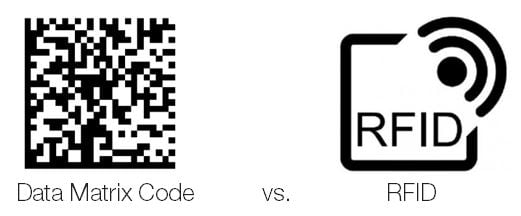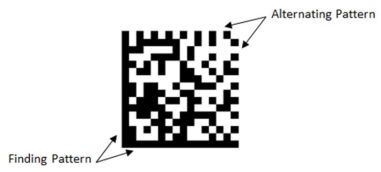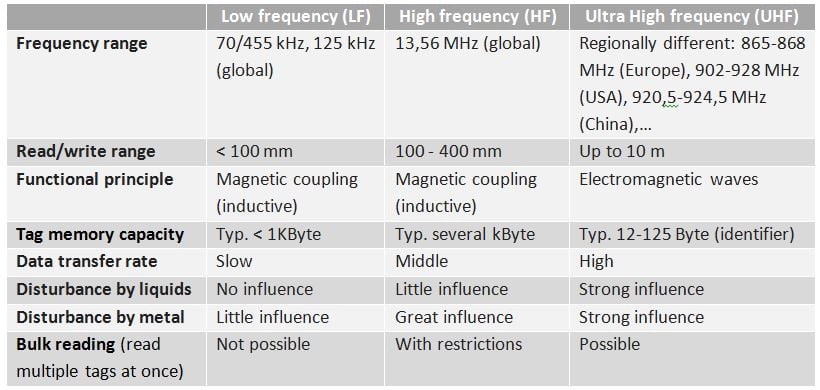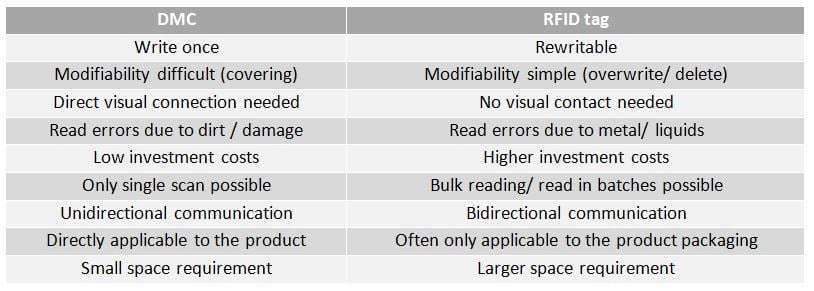The increasing discussions and regulations on complete traceability and reliable identification of products is making identification systems an inevitable part in manufacturing. There are two specific technologies that are very well received: The Data Matrix Code (DMC) and Radio Frequency Identification (RFID).

One critique of RFID is the market maturity regarding practicability and price-performance ratio is not reached yet. Compare this to DMC; DMC is practical and cost-effective which is an advantage over RFID. In order to choose DMC or RFID for your application, you have to understand the fundamental differences between the two technologies. Both have their advantages and disadvantages, and the wrong decision could have costly consequences. The technology you choose will mainly depend on the object being identified. The decision will be based off of size, shape and the environmental conditions.
A New World of Opportunities with DMC
A Data Matrix Code is a two-dimensional data point pattern that has a variable, rectangular size in the form of a matrix. The matrix consists of symbol elements with a minimum of 10×10 and a maximum of 144×144 . It is a binary code that is interpreted with zeros and ones and can hold up to 1,556 bytes.

A horizontal and a vertical border describe a corner, which serves as orientation for the reading – called the “Finding Pattern”. On the remaining sides, the border must alternate with light and dark square elements in order to describe the position and size of the matrix structure – the “Alternating Pattern”. The data storage area is inside the symbol.
Advantages of DMC
This machine-readable coding form was invented to encode higher amounts of data in smaller areas compared to 1D code. Camera scanners can already reliably read dot patterns of only 2mm by 2mm. Thus DMC is suitable for very small products or round surfaces where there is little room for marking on the product.
With the technology of DMC you can place a lot of information in a very small area. Article or batch numbers, manufacturing or expiration dates as well as other important manufacturing data can be stored permanently on the work piece across all processing steps.
A particular strength also lies in the fact that the code can be directly applied to a part (without a label) using different printing or embossing methods. It can be needled, lasered or printed with inkjet or thermal transfer printing. It works with various materials: plastics, papers, metals and many more. Since you have to use special cameras to read the DMC, not barcode scanners, they can be read in any orientation (from 0°-360°).
Additionally, the error correction when reading a DMC is very high due to information redundancy and error correction algorithm, even 25-30% contamination or damage of the data field can be fully compensated.
Disadvantages of DMC
As it is not possible to read a DMC with linear barcode scanners, you have to use camera-based image processing systems that are more expensive. In addition, it is imperative that the entire surface (not just a part of it) is decoded, because the arrangement of the modules on the surface determines the contained data. Otherwise you don’t get any valuable information.
Although DMC can accommodate low-contrast printing (20% contrast are sufficient), glossy surfaces are difficult to handle because either the light used by the camera for reading is not optimally reflected or it is too scattered. The angle at which the camera is mounted can also play a role.
Last but not least, the location of the DMC or its attachment determines whether it is readable or not. Unlike RFID, a DMC can only be read with visual contact. A hidden DMC cannot be read by the cameras. Even if there is a line of sight you can read the DMC only within a specific reading distance.
Gain Visibility into the Manufacturing Process with RFID
This technology makes it possible to identify every item that is equipped with an RFID data carrier contactless and unambiguously. An RFID system in manufacturing consists of thousands of data carriers (also called tags or transponders) and a minimum of one read/write device (usually called a reader) with an antenna.
The reader generates a weak electromagnetic field via its antenna. If you bring a tag into this magnetic field, the microchip of the tag is supplied with energy and can send data (without contact) to the reader or store new information on the chip. If the tag leaves the magnetic field, the connection to the reader breaks off and the chip is inactive again. The stored data will remain in the tag memory.
RFID tags are available in many different designs, it can be just a simple adhesive tag but also a hard tag as a disc, bolt or glass tag. Only a few millimeter tags can be used for tool identification and very large transponders for container identification.

Advantages of RFID
An RFID tag has 3 main advantages:
- The tag can be read or written contactlessly without visual contact to the reader
- The tag has almost unlimited rewritability
- Several tags can be read simultaneously (multitag/bulk reading)
These features open up completely new possibilities that DMC cannot provide. If the RFID tag is integrated in a pallet or tool and you can’t even see it, it can still be identified. RFID tags can also be read with the greatest possible contamination as no visual contact is needed. With the rewritability of the tags you have the chance to change, delete or supplement the data on the chip – at any time.
Once an RFID system is integrated into a process, the system can be run with just minimal human participation. For a new order, the new information is written automatically on the tag. This can be up to 128 kbyte of data on a single tag. The detection of RFID-equipped parts happens within less than a second, much faster than using a barcode. This leads to reduced administrative errors, increased transparency and significant increase of speed.
With RFID, even after a post-treatment, parts can be tracked down for a lifetime. Every production step can be documented, read and written directly on the RFID tag in or on the part. To avoid security issues, data can be encrypted, password protected or set to include a “kill” feature to remove data permanently.
Disadvantages of RFID
RFID also has some disadvantages. Depending on the used frequency, physical conditions are often the reason for issues. For example, metal containers or contents made of metal can create problems or even non-readings as metals reflect and shield. Products with a high proportion of water absorb radio waves and it could cause the reader to not detect certain objects.
Another sore point is the cost. RFID tags are always more expensive than a DMC because even with a large amount, the integrated antenna and the transponder must be paid. However, with having almost unlimited read and write capabilities, the higher initial acquisition costs pay off over the time with tens of thousands of uses of the tags – at least with closed-loop applications.
Different frequencies for different applications
There are 3 established radio frequency ranges that have specific characteristics:

The application determines which frequency you should choose. As Low Frequency (LF) systems only have a moderate sensitivity for potential metallic reflections they are designed for applications where the tag has to be mounted flush in metal, for example, with tool identification. High Frequency (HF) systems score with a high transmission speed for large volumes of data and are therefore ideal for work in progress (WIP) applications. High reading ranges make Ultra High Frequency (UHF) very attractive when the plant or process does not allow a close proximity between reader and tag, RFID tags on various positions on an item can be read with just a single UHF antenna. As all tags can be read out almost simultaneously in the read range of a reader, UHF systems are ideal for detecting complete pallet loads.
Main Differences Between DMC and RFID Tags
Here is an overview of the most important differences between Data Matrix Code and RFID:

Which Option is Better for Your Application?
Ultimately, the decision to opt for one or the other technology is always a case-by-case decision. Here are some fundamental questions you can ask yourself in order to choose the right one:
- Will the marked object be reused or will it be lost at the end of the processing chain? → closed-loop application = RFID, open loop application = DMC
- Is there only a one-time marking or a repeated writing/ change of the stored data needed within the processing chain? → One-time marking = DMC, rewriting = RFID
- How big are the detection distances? → Short = DMC, large = RFID
- What about the data volume on the object? → Low = DMC, high = RFID
- Should process data be stored on the object? → Yes = RFID, no = DMC
- What about the processing speed? Not relevant = DMC, high = RFID
- What about the lighting conditions and contrasts? → Good = DMC, bad = RFID
- How big is the space available for the marking? → Small = DMC, sufficient = RFID
- Is the direct line of sight to the object difficult? → Yes = RFID, no = DMC
- Are there potential sources of interference like dirt or damage? → Yes = RFID, no = DMC
- Are there potential sources of interference like metals or liquids? → Yes = DMC, no = RFID
It’s Not Always About “Either/Or”
DMC and RFID do not necessarily have to compete. Sometimes it may be beneficial to have a combination of both technologies. An example of a combination solution is an RFID label with a printed DMC. While the DMC can be read directly on the object with a scanner, the RFID tag fulfills further tasks. Thanks to the special technology, goods can be identified even when packaged. In addition, all relevant process data can be stored on the RFID data carrier and offer added value throughout the value chain.
To learn more about RFID technology, please visit www.balluff.com.
























